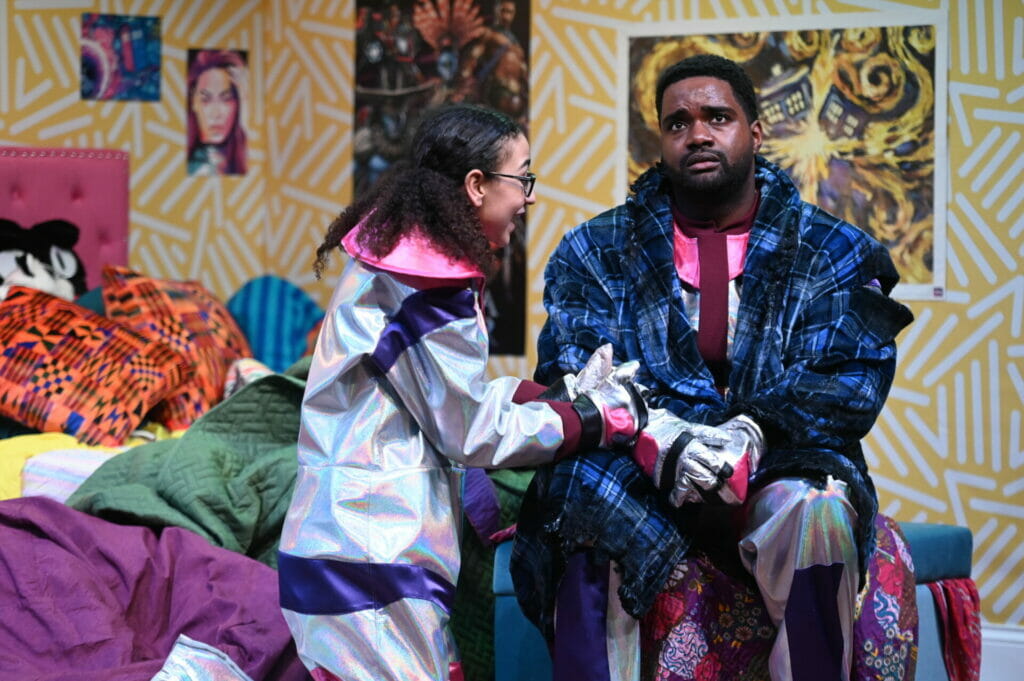[ad_1]
There are very few things Jasmine Starr-Kidd doesn’t know, and if she’s in a pinch, she can always ask her artificial intelligence computer, Grace. The daughter of a middle school science teacher and a world-renowned physicist, Jasmine is ready to outsmart her parents and get them back together. When she finds a hole in the space-time continuum, she’s determined to go back in time. To complete her mission, she enlists the help of Grace, the U.S. government, her not-so-secret admirer Todd and her cool uncle Craig. However, in the Alliance Theatre’s production of Stephen Brown’s The Many Wondrous Realities of Jasmine Starr-Kidd — onstage through April 1 — this 12-year-old genius must learn that there are some problems technology can’t solve.
Smartly directed by interim co-artistic director Tinashe Kajese-Bolden, Starr-Kidd is the winner of the Alliance/Kendeda National Graduate Playwriting Competition. For the last 19 years, the Alliance has offered students who are earning their master’s of fine arts in playwriting to submit a script for a world premiere production. Brown is a fellow in the Juilliard School’s Lila Acheson Wallace American Playwrights Program.
Starr-Kidd will feel familiar for fans of young adult fiction and the Netflix shows The Expanding Universe of Ashley Garcia and Never Have I Ever. But for tween/teen theater, it is a step in a new (and right) direction. Jasmine is written as a biracial science nerd, which is not an archetype in the American theater, but perhaps it should be. After all, theater often mirrors and/or transcends real life. According to the American Institute of Physics, women only make up about 20% of physicists and less than 4% of bachelor’s degrees in physics are awarded to Black women. Starr-Kidd offers a different view of who can be an inventor or a mischievous risk-taker.

Penny Schick, the high school freshman who plays Jasmine, is a burst of energy onstage from start to finish. Schick makes her Alliance debut in this role, and there’s no doubt she’ll be back. Kudos to Kajese-Bolden for guiding Schick to Jasmine’s obsessive behavior and humor with a deftness beyond her years. She and Brandon Burditt, who plays Uncle Craig, bounce jokes off of each other well, and their scenes are where the play really shines.
There’s also Jasmine’s relationship with Grace, the computer with a caustic wit played by Sydney Terry. For their characters, Terry, who is never seen onstage, and Schick have the shorthand of besties. Grace is Jasmine’s invention, but at some point, she is not Jasmine. With all of the conversations about artificial intelligence going rogue and developing personalities in real life, it was fun to watch Brown address this in the script. In his case, he explored the idea that maybe our robots can touch our hearts.
Also rounding out the talented cast are Jeremy Aggers, who plays Doug, Jasmine’s endearing dad; Dana Deveaux, who plays Jasmine’s ambitious and kind mother; and Joe Knezevich, who plays Todd plus a very loose-lipped general at the Department of Defense.
If there’s any stumbling block for this production, it’s in the reliance on Grace to give exposition and using computers to show Jasmine’s conversations with friends and family on social media apps. This is real life for most teens these days, but watching Jasmine talk to Todd on the computer along with the long artificial intelligence monologues can sometimes stop the flow of the action. However, these moments are short lived and the cast always hits the punchlines.

The other star of the show is the very cool set design by Caite Hevner, who also designed the projections. Jasmine’s bedroom is colorfully decorated with posters of Amanda Gorman, computer-generated illustrations and Wakanda Forever affixed to yellow and white tribal print wallpaper. Her floral quilt is accented by kente cloth throw pillows. Everything in the room is about combining different aspects of her racial identity. Then there’s the time machine itself, which is hard not to want to climb inside. Part of the show’s humor is that the family readily accepts this giant metal machine sitting in the middle of her bedroom and causing the electricity to go out, no big deal.
Kudos also go to Ben Rawson’s lighting design, which entails flashing lights on the machine, blackouts, Grace’s inevitable meltdown and more. Because this is a dialogue-heavy play, the constant flickering and flashing of lights helps to keep the energy up while Jasmine is explaining her theories.
The Many Wondrous Realities of Jasmine Starr-Kidd is a funny play that the whole family can enjoy. In Brown’s interview in the show program, he said that when he wrote the character of Jasmine, he wanted to create someone his children, who are also biracial, can look up to. He has accomplished exactly that, as well as created a space for audiences to place a new face next to the photos of women scientists on display in the Hertz Theatre lobby.
::
Kelundra Smith, an ArtsATL Editor-at-Large, is a critic and arts journalist whose mission is to connect people to cultural experiences and each other. Her work appears in The New York Times, ESPN’s Andscape, American Theatre and elsewhere. She is a member of the American Theatre Critics Association and the Society of Professional Journalists.
[ad_2]
Source link

